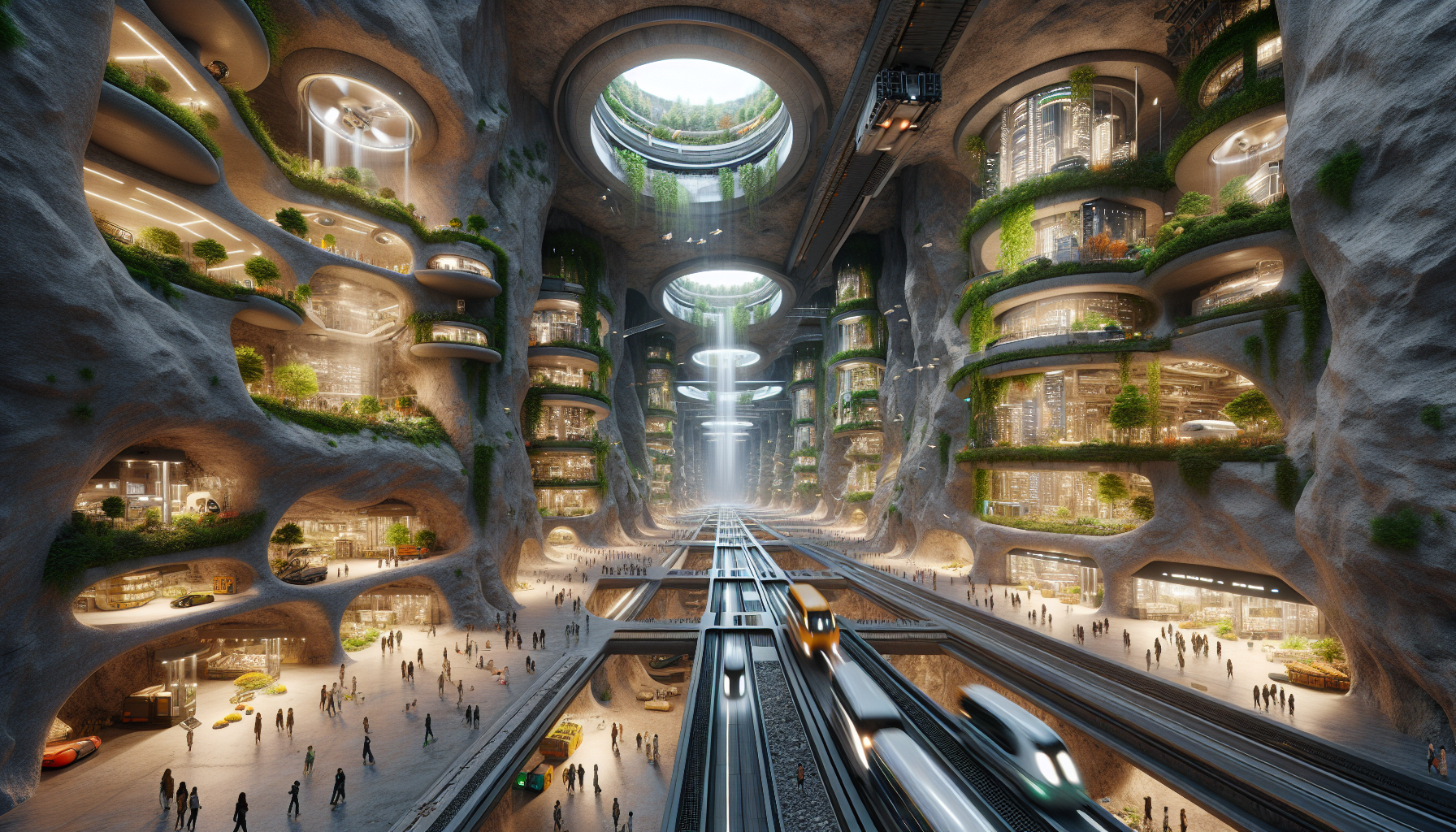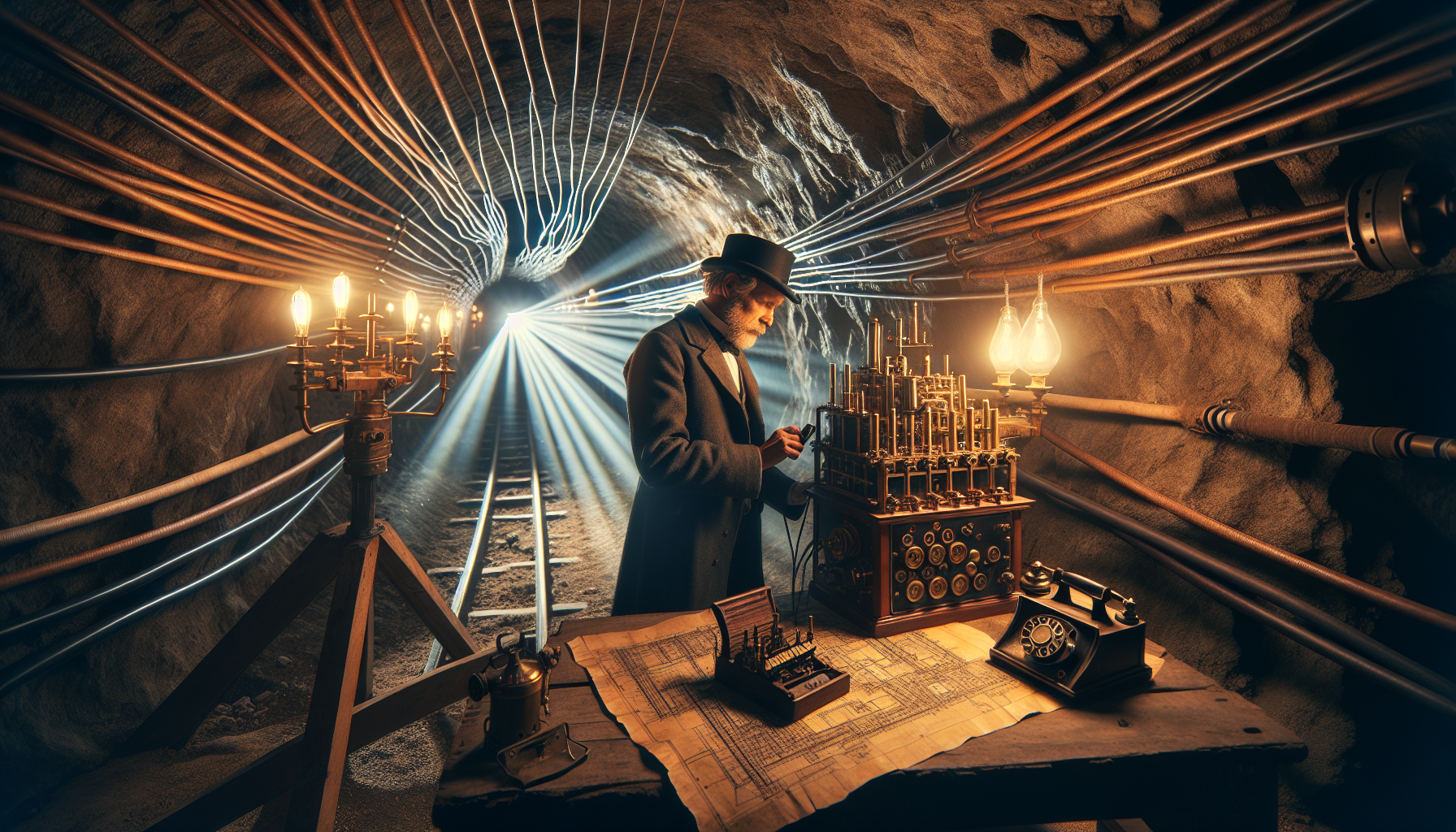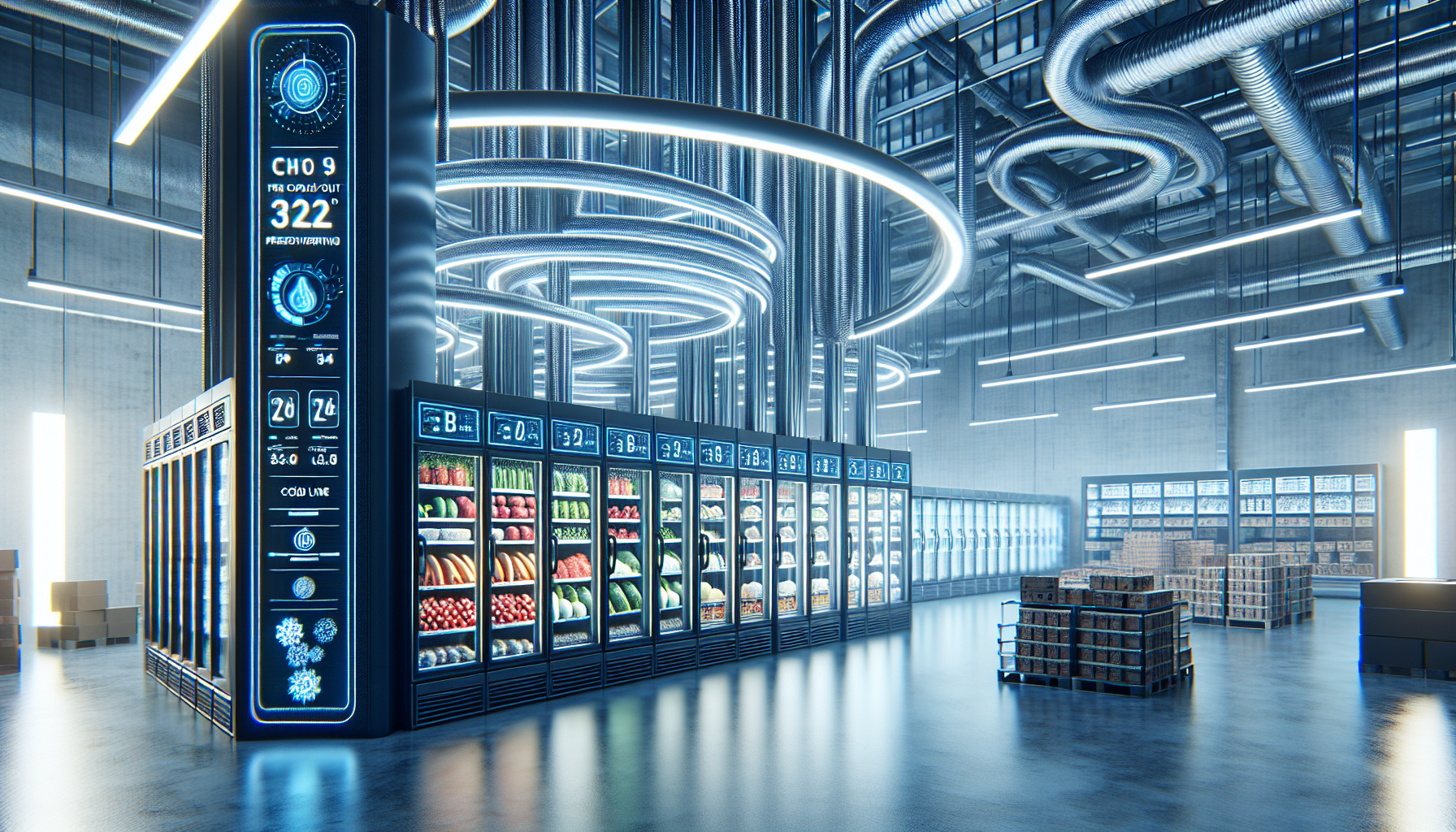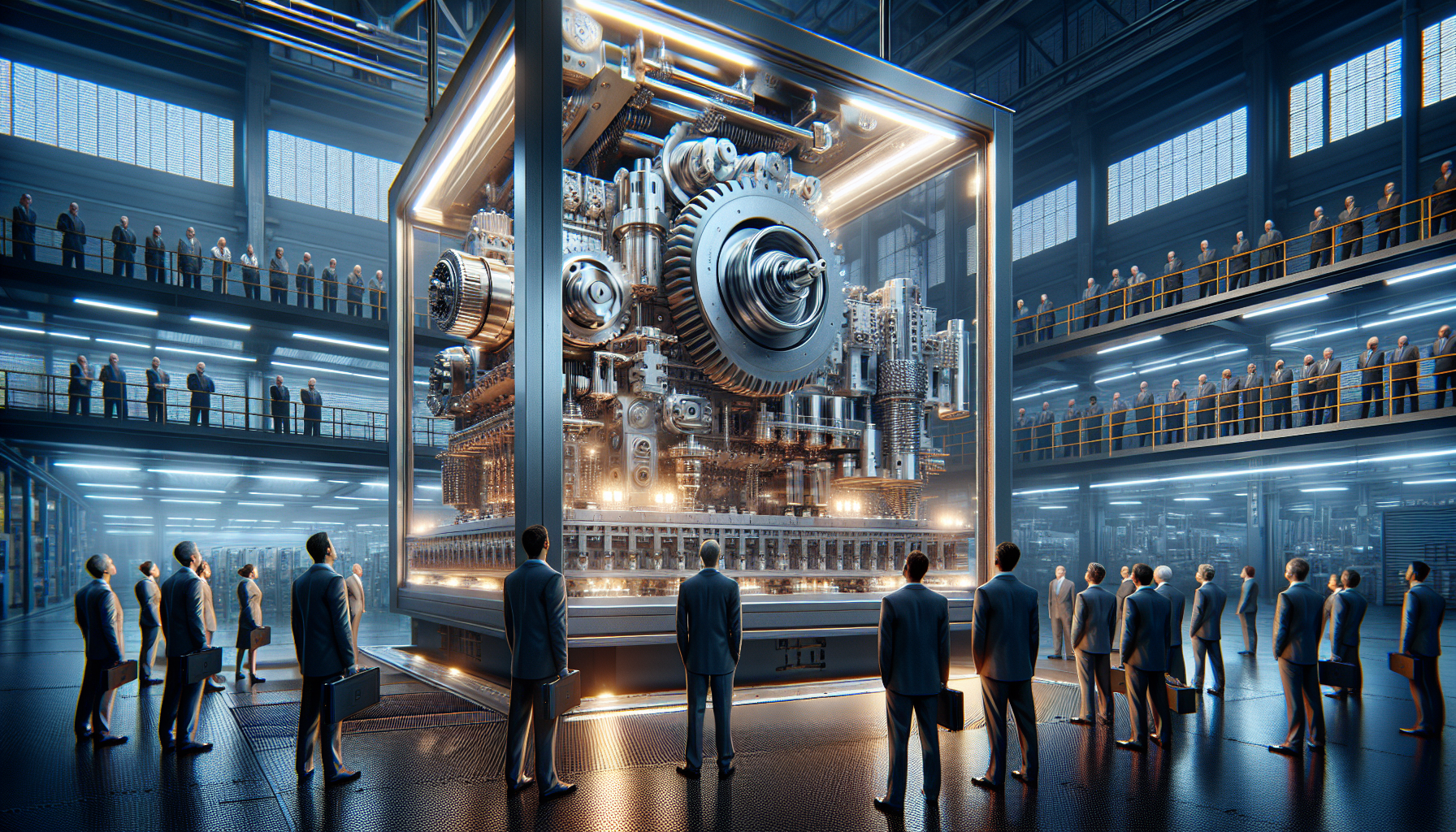In the hustle and bustle of our ever-expanding urban jungles, where skyscrapers touch the heavens and the hum of life never ceases, there lies an intriguing and often overlooked frontier — the world beneath our feet. Imagine a city not sprawling outward, but delving deeper into the earth, where innovation meets necessity, and where the future of urban living may well be shaped. Welcome to the hidden world of underground cities, a realm that challenges our conventional understanding of urbanization and offers a glimpse into an extraordinary future. 🌍
As the global population continues to soar and metropolitan areas grapple with space constraints, environmental challenges, and the relentless demand for resources, the concept of subterranean urbanization emerges as a fascinating solution. This is not a mere flight of fancy or the realm of science fiction; rather, it is a burgeoning reality that holds the potential to revolutionize how we live, work, and interact with our environment. From the ancient catacombs of Paris to the intricate networks beneath Montreal and the ambitious subterranean projects of Helsinki, underground cities are steadily gaining traction as viable alternatives to traditional urban expansion.
In this article, we will embark on a journey through the depths of this hidden world, exploring the myriad possibilities that underground cities present. We will delve into the technological advancements that make such developments feasible, examine the environmental and economic benefits, and consider the cultural and psychological implications of dwelling beneath the surface. What are the architectural marvels that enable life underground? How do these cities ensure sustainability and resilience in the face of climate change? And what does living below ground mean for our sense of community and connection to the natural world? These are the questions we will seek to answer as we uncover the future of underground living.
Prepare to have your perspective transformed as we navigate through the visionary concepts and real-world examples that illustrate the untapped potential of subterranean urbanization. Whether you’re a city planner, an environmental enthusiast, or simply someone curious about the future of our cities, this exploration promises to challenge your preconceptions and ignite your imagination. Join us as we venture into the depths, where the fusion of human ingenuity and the earth’s natural shelter may hold the key to a sustainable, innovative, and awe-inspiring urban future. 🏙️✨
The Concept of Underground Cities: History and Vision
The idea of underground cities isn’t entirely new. Throughout history, civilizations have ventured beneath the surface of the Earth for various reasons, including protection, resource optimization, and environmental stability. From the ancient Derinkuyu in Turkey to the more contemporary Montreal’s RESO in Canada, the evolution of subterranean living spaces demonstrates humanity’s adaptability and ingenuity. The quest to establish underground cities is motivated by a combination of environmental challenges, urban congestion, and the ever-increasing demand for sustainable development. Understanding the historical context and motivations behind such ventures is crucial as we explore their future potential.
Historically, underground spaces have been utilized as shelters during wars, offering protection from invasions and natural disasters. The labyrinthine networks of tunnels in Derinkuyu, for instance, provided refuge for thousands of people. These ancient marvels demonstrate the potential for human life beneath the Earth’s surface. In modern times, underground cities like Montreal’s RESO, which spans over 33 kilometers, cater to the needs of urban populations by providing accessible amenities shielded from harsh weather conditions. These developments highlight how underground spaces can efficiently manage urban sprawl while offering unique solutions to contemporary challenges.
The vision for future underground cities is far more ambitious. Architects and urban planners envision cities that are entirely self-sustaining, leveraging advanced technology for energy, agriculture, and communication. The integration of smart systems to regulate temperature, humidity, and lighting conditions makes underground living not only feasible but potentially desirable. This vision extends beyond mere survival, embracing the concept of thriving urban communities that coexist harmoniously with the environment. Such cities could mitigate the impacts of climate change, reduce our carbon footprint, and provide new opportunities for economic and social growth.
Technological Innovations Driving Underground Urbanization
Technology plays a pivotal role in the realization of underground cities. Advances in construction, energy, and environmental control are critical in overcoming the challenges associated with subterranean living. The development of cutting-edge tunneling and excavation methods allows for the efficient creation of vast underground spaces. Technologies like tunnel boring machines (TBMs) and advanced rock-cutting techniques have revolutionized our ability to carve out spaces beneath the Earth’s surface, making large-scale projects more feasible and less disruptive to the surface environment.
Energy sustainability is a significant concern for underground cities. The development and implementation of renewable energy sources, such as geothermal and solar power, are vital for maintaining a stable and sustainable energy supply. Geothermal energy, in particular, is well-suited for underground environments, providing a consistent and reliable energy source with minimal environmental impact. Additionally, advancements in energy storage and distribution technologies ensure that energy needs are met efficiently and sustainably. These innovations are crucial for maintaining the viability of underground living spaces and reducing reliance on external resources.
Environmental control technologies are another essential component of underground urbanization. Systems for regulating air quality, temperature, and humidity are necessary to create comfortable living conditions. Innovations in air purification and ventilation ensure that underground residents have access to fresh, clean air. Moreover, the use of smart technologies to monitor and control environmental parameters enhances the livability of subterranean spaces, making them more attractive to potential inhabitants. These technologies, combined with energy sustainability initiatives, lay the groundwork for the development of functional and appealing underground cities.
Challenges and Solutions in Developing Underground Cities
Developing underground cities presents a unique set of challenges, from technical and engineering issues to social and psychological considerations. One of the primary technical challenges is ensuring structural integrity and safety. The construction of underground spaces requires careful planning and engineering to prevent collapses and ensure the stability of the surrounding environment. Advances in geotechnical engineering and the use of robust construction materials mitigate these risks, but ongoing monitoring and maintenance are essential to ensure the long-term safety of subterranean infrastructures.
Social and psychological factors also play a significant role in the viability of underground cities. Human beings are naturally inclined towards open spaces and sunlight, making the transition to underground living potentially challenging. To address these concerns, designers incorporate natural elements into underground environments, such as green spaces and artificial lighting systems that mimic natural light. Psychological studies and community engagement are crucial in understanding and addressing the social dynamics of subterranean living. These efforts aim to create environments that are not only functional but also psychologically comfortable and fulfilling.
Financial and economic considerations are also critical in the development of underground cities. The costs associated with construction, maintenance, and operation can be significant, requiring substantial investment and economic planning. Public-private partnerships and innovative funding models are essential in securing the necessary resources for these projects. Additionally, the economic benefits of underground cities, such as reduced land use and increased urban density, must be carefully balanced against the costs to ensure their long-term sustainability and success.
Comparative Analysis of Existing Underground Spaces
To better understand the potential and challenges of underground cities, it’s helpful to compare existing subterranean spaces. Let’s examine some notable examples:
| Location | Purpose | Size | Unique Features |
|---|---|---|---|
| Derinkuyu, Turkey | Shelter | Up to 20,000 people | Multi-level underground city with ventilation shafts |
| Montreal RESO, Canada | Commercial & Residential | Over 33 km | Integrated network of retail, hotels, and transport |
| Helsinki, Finland | Recreational & Infrastructure | Various facilities | Includes swimming pools and data centers |
These examples illustrate the diverse applications and benefits of underground spaces, from ancient shelter to modern urban integration. They serve as valuable case studies in understanding how future underground cities might be developed and utilized.
The Future of Underground Cities: Opportunities and Impacts
The future of underground cities holds immense potential for transforming urban landscapes and addressing global challenges. The ability to expand urban areas without consuming additional surface land presents a significant opportunity for sustainable development. Underground cities can help alleviate urban congestion, reduce environmental impact, and provide resilient infrastructure in the face of climate change. Moreover, they offer a unique opportunity to reimagine urban living, incorporating innovative designs and technologies that prioritize sustainability and human well-being.
In terms of economic impact, underground cities have the potential to stimulate new industries and job opportunities. The construction and maintenance of subterranean infrastructures require specialized skills and expertise, creating demand for a diverse workforce. Additionally, the development of underground commercial spaces can attract businesses and investments, contributing to local economies. The economic benefits extend beyond the construction phase, with ongoing operations and services supporting sustained growth and prosperity.
Socially, underground cities could foster new forms of community and connectivity. The unique environments and shared experiences of subterranean living may encourage a sense of cohesion and collaboration among residents. By prioritizing inclusivity and accessibility, these cities can offer equitable opportunities for all inhabitants, regardless of socioeconomic status. Moreover, the integration of smart technologies and green spaces can enhance the quality of life, promoting health, well-being, and social interaction.
Watch this insightful video on the potential of underground cities: “The Future of Urban Living: Subterranean Cities” by Future Insights 📺
Environmental Considerations and Sustainability in Underground Cities
Sustainability is a fundamental consideration in the development of underground cities. The environmental impact of subterranean construction must be carefully managed to ensure that these projects contribute positively to ecological balance. One of the primary environmental benefits of underground cities is their ability to reduce surface land use and preserve natural habitats. By relocating urban infrastructure below ground, valuable surface space can be conserved for agriculture, recreation, and wildlife conservation, promoting biodiversity and ecosystem health.
Water management is another critical aspect of sustainability in underground cities. Effective systems for rainwater harvesting, wastewater treatment, and groundwater recharge are essential to minimize environmental impact and ensure a reliable water supply. The integration of green technologies, such as permeable surfaces and bioretention systems, can enhance water management efforts, contributing to the overall sustainability of subterranean living spaces. These measures not only support environmental conservation but also enhance the resilience of underground cities to climate change impacts.
- Reduced Surface Impact: Preserves land for agriculture and recreation.
- Efficient Water Management: Integrates sustainable water systems.
- Energy Sustainability: Utilizes renewable energy sources.
- Enhanced Resilience: Supports climate adaptation and mitigation.

Conclusion
Certainly! Here’s a comprehensive conclusion for the article on underground cities:
—
As we journeyed through the fascinating world of underground cities, we explored their historical significance, modern developments, and the potential they hold for the future. The concept of subterranean living has evolved from ancient catacombs and bunkers into a viable solution for contemporary urban challenges. This exploration uncovered the innovative designs, environmental considerations, and technological advancements that make underground cities an exciting prospect for sustainable living.
Recap of Key Points
Our exploration began with a look at the historical precedents of underground cities, highlighting how ancient civilizations like the Cappadocians and the builders of Derinkuyu and Naours utilized the earth’s depths for protection and sustenance. These early examples provided a foundational understanding of how underground spaces can serve human needs.
We then shifted our focus to the modern era, examining projects like Montreal’s RESO and Helsinki’s underground master plan. These examples showcase how urban planners and architects are reimagining subterranean spaces to accommodate growing populations while mitigating the impact on surface environments. By prioritizing sustainability and energy efficiency, these developments illustrate the potential of underground cities to reduce urban sprawl and carbon footprints.
The technological advancements driving these projects were another critical area of focus. Innovations in construction, ventilation, and lighting systems are overcoming traditional barriers to subterranean living. For instance, the use of LED technology and fiber optics to simulate natural light can significantly enhance the livability of these spaces. Moreover, geothermal energy and advanced water recycling systems offer sustainable solutions for resource management.
Importance of the Topic
The importance of exploring underground cities cannot be overstated. As urban populations continue to grow, the need for innovative solutions becomes more pressing. Underground cities present a unique opportunity to expand habitable space without encroaching on valuable natural landscapes. They offer a way to rethink urban development, providing resilience against climate change, natural disasters, and other challenges facing modern cities.
Moreover, the exploration of underground living forces us to reconsider our relationship with the environment. By integrating natural elements into underground designs and prioritizing eco-friendly practices, we can create harmonious spaces that respect the planet’s limits.
Call to Action
As we conclude this exploration, it’s essential to reflect on how these insights can be applied in our own lives and communities. Whether you’re an urban planner, architect, or an enthusiastic reader, consider how you can contribute to the conversation about sustainable urban development. Share this article with friends, colleagues, and anyone interested in innovative solutions for the future of cities. Your engagement helps raise awareness and encourages further research and development in this exciting field.
For those inspired to delve deeper, numerous resources are available online. Websites like ArchDaily and Urban Land Institute offer valuable insights into the latest trends and projects in urban development. Additionally, keep an eye on academic publications and journals that frequently explore the intersection of technology, architecture, and sustainability.
In closing, the hidden world beneath our feet is brimming with potential. By embracing the possibilities of underground cities, we not only address the pressing challenges of today but also pave the way for a more sustainable and resilient future. Let’s continue to explore, innovate, and inspire change in our urban landscapes. Together, we can uncover a future where cities harmoniously coexist with the natural world, ensuring a thriving planet for generations to come. 🌍✨
—
This conclusion aims to encapsulate the main points of the article while encouraging reader engagement and exploration of the topic.
Toni Santos is a visual researcher and design historian whose work excavates the hidden aesthetics of Cold War underground architecture. Through a precise and atmospheric lens, Toni explores the secretive world of bunkers, fallout shelters, and subterranean control rooms—spaces where fear met function and design became a quiet weapon of survival.
His journey is anchored in a fascination with how psychology, geopolitics, and architecture collided beneath the surface. From brutalist safe havens carved into mountains to color-coded civil defense manuals, Toni’s narratives reveal how underground design reflected not just strategic utility, but an entire culture of suspicion, endurance, and visual control.
With a background in archival visual storytelling and spatial design theory, Toni reconstructs the emotional and symbolic language of Cold War interiors—highlighting sterile aesthetics, retro-futuristic technology, and the unspoken codes of protection embedded in every detail.
As the curator of Vizovex, Toni shares rare blueprints, visual analyses, and interpretive essays that bring forgotten Cold War spaces back into the cultural imagination—offering a deeper understanding of the architecture of anxiety and hope.
His work is a tribute to:
The visual psychology of Cold War safety design
The overlooked beauty in utilitarian environments
The role of design in shaping perception during times of fear
Whether you’re a student of history, a lover of mid-century design, or someone drawn to the unseen layers of the past, Toni invites you underground—where silence was strategy, and every bolt, map, and fluorescent bulb held meaning.





